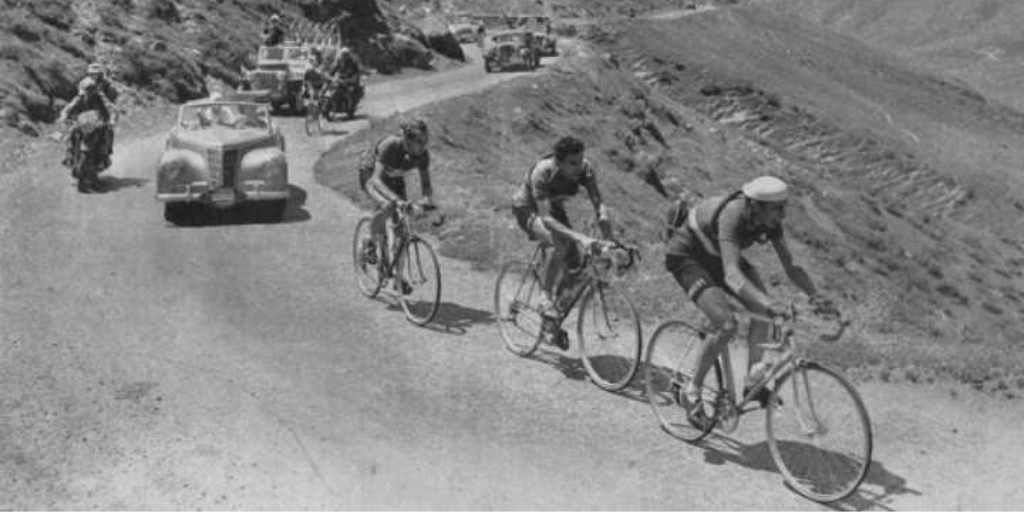The 38th Tour de France between 4th and 29th July 1951 was the first edition which visited the interior of France, most importantly the Massif Central and the Mont Ventoux.
The French national team was the strongest with Jean Robic, Rafael Geminiani and Louison Bobet who was considered to be the main favourite of the race.
The Italians had their big trio, Gino Bartali, Fausto Coppi and Fiorenzo Magni. A year ago the team with Bartali and Magni (actual GC leader) left the race among scandalous circumstances. At the beginning of the Tour in 1951 Coppi has his own personal problems: his brother Serse died just a few days before following a crash at a race. Fausto was far behind his best form, but he was still racing the French Grand Tour.
The previous winner Ferdi Kübler was absent from the race. The reason might have been the question of the leadership inside the Swiss team. After having the most successful period of his career, Kübler didn’t want to be the domestique of Hugo Koblet, the winner of the Giro d’Italia 1950.
Koblet, the playboy, “Le Pédaleur de Charme” attacked on the first stage already, but was caught by the peloton relatively soon. He won the 85 km long individual time trial on the 7th stage after he protested against the possibly miscalculated time of Louison Bobet at the intermediate checkpoint.
Then the famous 11th stage came when he attacked again. The stars of the peloton thought he is on a suicide mission because it was before both the Pyrenees and the Alpes. Nobody, especially no favourite would waste his energy on a plain stage before the big mountains. Anyway, Louis Deprez joined him for a while, but at the end, Koblet rode more than 100 km in solo. The peloton started to chase him seriously when it was already too late.
Before Koblet crossed the finish line, he combed his hair – a psychological weapon, a demonstration, how easy the stage was. It wasn’t the first time, Koblet already did the same gesture on the hardest climb of the Tour de Suisse. After he crossed the line, he started to watch his own stopwatch, because, after the 7th stage, he didn’t trust the timekeepers of the race anymore. After this stage, Koblet jumped up to the third position in the GC. He was the best among the big favourites, Geminiani (6.) was more than 3 minutes behind him, while Bobet (9.) more than 5 and Coppi (10) almost 6 minutes.
The next stage was another plain one, won by Wim van Est, who took the yellow jersey. He became the first Dutch cyclist to wear the famous kit. Unfortunately, he couldn’t hold his position for too long. The 13th stage was the first day in the Pyrenees, and van Est, who never races in high mountains before, tried to keep with the experienced downhill rider Fiorenzo Magni down from the Aubisque. The Dutch rider fell into a ravine. He was rescued but his race was obviously over. Raphael Geminiani won the stage, but later he was relegated to the 4th position.
On the 14th stage (Tourmalet, Aspin, Peyresourde) Coppi dominated the race. Koblet had a puncture before the top of Tourmalet, but he remained calm and after the problem was solved he was chasing Coppi successfully. They rode to together to the finish line, where Koblet outsprinted Coppi. He took also the yellow jersey on that very day. After the stage only Gilbert Bauvin (21 sec ) and Raphael Geminiani had a reasonable small gap (32 sec), the 4th placed Coppi was already more than 5 minutes behind the race leader.
Stage 16 – another plain stage – delivered further memorable moments. Coppi was in very bad form, allegedly due to a food poisoning. He even had to stop and vomit. Bartali and Magni escorted him to the finish line, while Koblet won the stage.
When the Mont Ventoux was introduced to the Tour de France, it wasn’t summit finish. (The first time a Tour de France stage finished on the top of the hill was only in 1959.) The stage was won by Louison Bobet. Pierre Barbotin was the second and a small group including the yellow jersey rider (Bartali, Geminiani, Lucien Lazarides and Koblet) arrived 56 sec later.
A few days later on a stage in the Alpes (Stage 20 including Vars and Izoard), Coppi delivered a great performance. After the stage, he was in the GC top 10 again, but almost a half an hour behind Koblet. The race leader won also the last individual time trial (Stage 22) in Geneva (Switzerland) and two days later he could finally celebrate his overall victory in Paris.
Do you like stories from the good old days of road cycling?
Then you might like these stories too:
Peloton&Tales in on Patreon. Click the button below to learn ho to support the blog:

Follow Peloton&Tales on Instagram
A bejegyzés megtekintése az Instagramon
A bejegyzés megtekintése az Instagramon
A bejegyzés megtekintése az Instagramon
